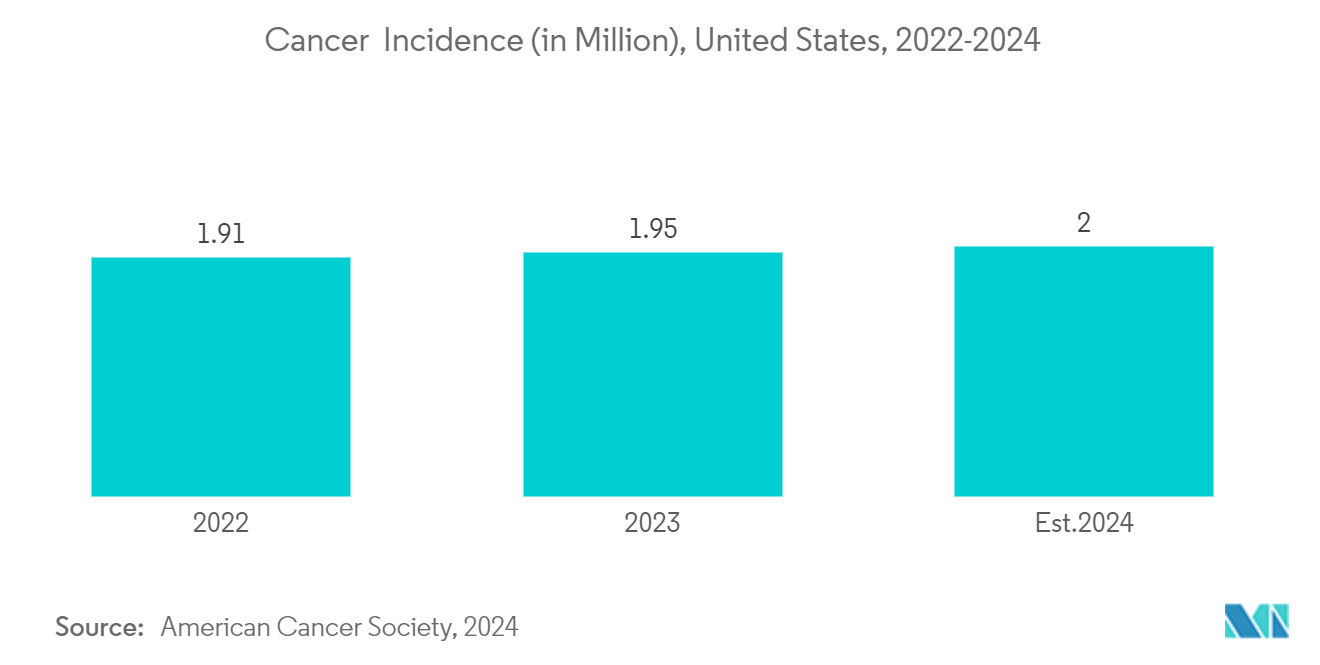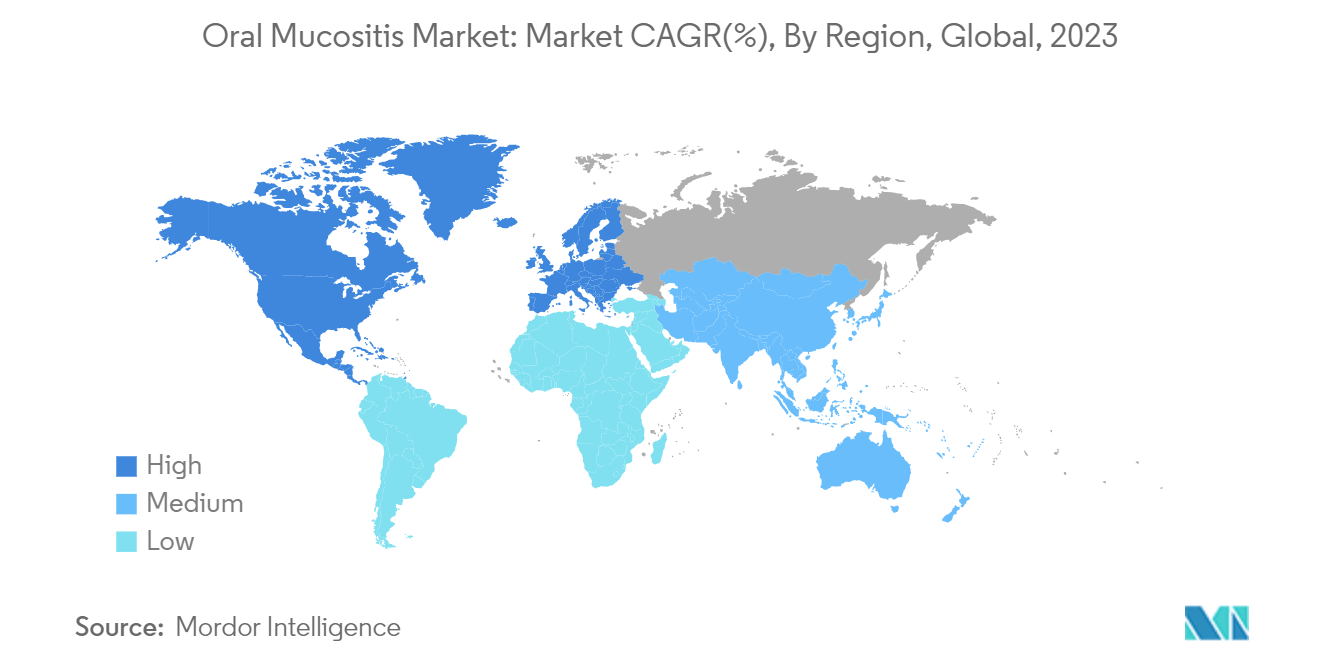Market Trends of Oral Mucositis Industry
The Chemotherapy-induced Segment is Expected to Witness Significant Growth Over the Forecast Period
The chemotherapy-induced oral mucositis segment is expected to witness significant growth over the forecast period owing to the rising burden of cancer among the population, rising adoption of chemotherapy as the treatment choice, and growing treatment options for chemotherapy-induced oral mucositis conditions in the market.
Chemotherapy is a common treatment for various cancers and is well-known to cause oral mucositis as a side effect. The favor of chemotherapy among cancer patients directly increases the demand for products and treatments to manage their oral mucositis. For instance, according to 2024 data published by the American Cancer Society, about 35,780 new cases of multiple myeloma are expected to be diagnosed (19,520 in men and 16,260 in women) in the United States in 2024, as compared to 35,730 in 2023. Similarly, as per the National Breast Cancer Foundation, about 310,720 women are expected to be diagnosed with invasive breast cancer in 2024 in the country. These data underscore the rising number of cancer cases, driving the demand for treatments like chemotherapy. However, this also elevates the risk of developing chemotherapy-induced mucositis, fueling the segment's growth.
Furthermore, as the number of patients undergoing chemotherapy grows, the incidence of oral mucositis also rises. This creates a larger market for treatments and supportive care products designed to address mucositis. For instance, according to 2024 data published by Mesothelioma, about 25% of cancer patients receive chemo each year in the United States. Similarly, as per data published in Cancer Care in May 2023, it was observed that about 12% of females with breast cancer (stage 1 and 2) undergo treatment involving mastectomy plus chemotherapy, and 10% of the people with colon cancer undergo colectomy and chemotherapy. This data demonstrates the high adoption of chemotherapy treatment options among cancer patients, which raises their risk of developing oral mucositis, which, in turn, is anticipated to drive the growth of the oral mucositis market over the forecast period.
Various studies were conducted to assess the effectiveness of oral solutions in the management of oral mucositis among patients undergoing chemotherapy. For instance, according to a study conducted in the Babylon Oncology Center at Babylon Governorate, published in Oncology and Radiology in September 2023, it was observed that the application of a magic solution enhanced the chemotherapy-induced oral mucositis. This demonstrated that magic solution is effective for treating oral mucositis. Thus, such studies are anticipated to boost the adoption of oral solutions for the management of oral mucositis among the population, which is expected to spur market growth over the forecast period.
Therefore, owing to the rising burden of cancer cases, the adoption of chemotherapy as a treatment option, and growing research studies, the segment studied is anticipated to grow over the forecast period.

North America is Expected to Hold Significant Market Share Over the Forecast Period
North America is poised for substantial market growth during the forecast period, driven by factors such as a high cancer incidence, the adoption of advanced treatments like chemotherapy and radiation, a robust healthcare infrastructure, and significant R&D investments leading to novel treatments and product launches by key players.
North America has a pronounced prevalence of cancers, notably head and neck, hematological, and lung. The rising application of chemotherapy and radiation not only underscores the region's cancer treatment approach but also heightens the occurrence of oral mucositis, a condition anticipated to drive market expansion. For instance, according to the 2024 data published by the American Cancer Society, about 234,580 new cases of lung cancer are expected to be diagnosed in the United States in 2024. Similarly, the 2023 report from Canadian Cancer Statistics revealed a rise in cancer cases from 233,000 in 2022 to 239,000 in 2023 in Canada. This escalating cancer burden signals the growth of the oral mucositis market in the region over the forecast period.
Additionally, the increasing prevalence of type 1 diabetes among the population can manifest as oral mucositis symptoms or complications. These conditions often lead to oral cavity inflammation and ulcers, heightening the demand for specialized treatments. For instance, as per 2024 data published by the American Diabetes Association in the Statistics About Diabetes report, about 2.5 million Americans had type 1 diabetes in 2022, compared to 2 million people in 2021. Given that type 1 diabetes heightens susceptibility to oral health issues like oral mucositis due to factors like weakened immunity and reduced saliva production, the market is set for growth over the forecast period.
Furthermore, with the growing number of new product launches and approvals by regulatory bodies, the market is witnessing a surge in novel oral mucositis treatments, leading to heightened adoption and market expansion. For instance, in February 2023, Galera Therapeutics' new drug application for avasopasem manganese (GC4419), targeting radiotherapy-induced severe oral mucositis in head and neck cancer patients, received a priority review from the US Food and Drug Administration. Avasopasem acts as a selective small molecule dismutase mimetic, safeguarding normal cells from radiation damage.
Similarly, in March 2023, EpicentRx Inc. received Fast Track Designation from the US Food and Drug Administration for its RRx-001, a direct NLRP3 inhibitor and Nrf2 upregulator with anti-inflammatory and antioxidant properties, for the prevention/attenuation of severe oral mucositis in chemotherapy and radiation-treated head and neck cancer patients. Thus, the rising approvals of new drugs for treating oral mucositis are anticipated to propel their adoption, further bolstering the market growth over the forecast period.
Therefore, owing to the growing burden of cancer and the number of new product launches and approvals, the market studied is expected to grow over the forecast period.


